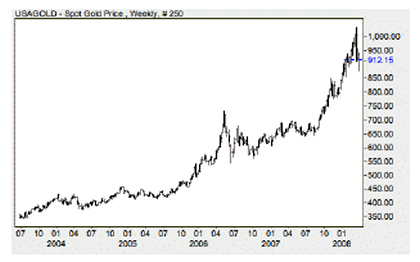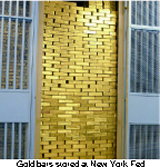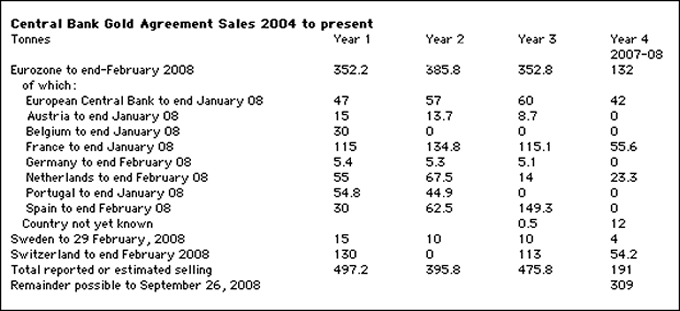An "ABCs of Gold Investing" Update
Commodities / Gold & Silver Apr 09, 2008 - 01:26 AM GMT "F" is for "Fundamentals"
"F" is for "Fundamentals"
Golden Gut Check - Why gold is likely to keep moving higher over the long run
"Gentlemen, this is a football." -
Coach Vince Lombardi at the start of Green Bay Packer football camp
Occasionally I like to take a close look at gold's fundamentals -- a gut check of sorts. It helps me get a deeper sense of what is driving the market. It also helps me reorganize my thinking around sound principles. Vince Lombardi, the legendary coach of the Green Bay Packers, always stressed knowing and understanding the fundamentals as the key to success on the football field. Likewise, learning the fundamentals is key to knowing and understanding gold. By doing so, you will become a more confident, better informed and successful gold owner.
From scarcity to shortages, the past is prologue
I cannot remember a time when the fundamentals have lined up more favorably for gold. The factors which have driven the price up over 75% over the past few years remain in place and in fact seem to be intensifying. The past, in this respect, could very well serve as prologue. Great forces, mostly benevolent, are at work in the gold market. Demand, as reported copiously by the mainstream financial press, continues to grow steadily on a global basis. It is on the supply side of the equation, however, where we now find the strongest arguments for resumption of the bull market. To come to the point, fundamental trends suggest that the gold market may be moving from a period of general scarcity to outright shortages. Unless some formidable source for gold is suddenly found, the period of shortages could come to full flower as early as 2008.
 Though benevolent forces seem to be guiding the gold market at the moment, there is, at the same time, a darker side to the emerging gold story. A shortage raises the possibility that investors who have yet to purchase gold (or plan to purchase more) might be crowded out of the market by major financial institutions and mining firms intent on squaring their physical short positions.
Though benevolent forces seem to be guiding the gold market at the moment, there is, at the same time, a darker side to the emerging gold story. A shortage raises the possibility that investors who have yet to purchase gold (or plan to purchase more) might be crowded out of the market by major financial institutions and mining firms intent on squaring their physical short positions.
The threat of a gold shortage should not be taken lightly. Recent reports of a rice shortage in Asia are a case in point. Nation states immediately began hoarding rice and governments put incentives in place to encourage production. The possibility for shortages applies to a range of key commodities, not just gold. Along these lines Goldman Sachs recently predicted explosive rallies in commodities led by crude oil rising to $175 per barrel. Shortages, hoarding, rapid price increases, breakdowns in international trade, a collapsing social order and the increased purchasing power of gold -- all typically accompany periods of currency debasement.
The mining companies face reduced production. . .
In 2005, the world's mines produced 2,550 tonnes of gold. In 2007, production had declined to 2,447 tonnes. Production, in fact, has been in steady decline for a number of years. Newmont Mining's Pierre Lassonde, who is generally considered one of the more savvy mining executives, explains why the mines have failed to increase production even with prices at record levels: "When is the last time we had a 30 million ounce discovery in the world? It's not in this decade, I can tell you that (and) it's not over the last 10 years. It's a long time ago. Look at exploration expenditures they are going up, but we are not getting the discoveries. And not only are we not finding them, but the ones we do find, they take forever to put into production." Lassonde goes on to say that in his view "it's not going to get any better at least for the next five years, and possibly for as long as the next 10 years."
. . .And forced covering of their forward sales
The steadily rising gold price has encouraged some mining companies (and forced others) to buy back their previous forward sales -- a process called dehedging. Though some analysts in the industry perennially predict the dehedging will slow, it has instead accelerated and become a major factor on the demand side of the gold balance sheet. In 2005, the mines dehedged 86 tonnes of metal. By 2007 that figure had grown to 400 tonnes -- a 465% increase.
When a mining company dehedges, it reverses its previous role as a seller in the fundamentals' equation and instead enters the market as a buyer. The effect on the supply-demand chart has been dramatic. What was once supply which acted to hold down the price has now become demand and an impetus to the price . This role reversal has contributed significantly to gold's steady rise over the past several years.
The plight of African mining giant AngloGold Ashanti is a case in point. Miningmx.com reports that Anglo is currently receiving 20% less than the spot price of gold (assuming a $900 price) due to its contracted forward sales. What's worse is that Anglo is contracted to deliver 60% of its hedge book over the next three years.
To buy its way out of the hedge, one top analyst believes a massive share issue amounting to one-third of the company's equity would be required. "It's a bombshell," he says, "and they are in more trouble with this hedge than anyone realizes." Thus not only will Anglo's shareholders experience hedging losses on the bottom line, they may be forced to suffer serious dilution of their interest as well.
For those who own the metal itself, such problems are grist for the mill. Anglo's forced purchases, no matter how they are financed, go straight into an already buoyant gold market. Keep in mind that the AngloGold Ashanti story is just one among many in the world of gold mining. "Being underwater" is an industry-wide problem. Analysts estimate the complete industry hedge book at roughly 1000 tonnes with additions still being posted annually.
Some key producing countries are keeping production at home
Have you ever asked yourself how much of the gold mined actually makes it to the open market? One would think that all the gold mined makes it to market. However, like much in the gold market, the answer to that question is more complicated than it appears on the surface.
 Few people know, for example that China, which became the top gold producer in the world this past year, is a net importer of gold. (Annually, it produces about 275 tonnes and consumes about 325 tonnes.) In short, the biggest market for Chinese gold is the Chinese people themselves, and the demand is large enough to consume everything China produces.
Few people know, for example that China, which became the top gold producer in the world this past year, is a net importer of gold. (Annually, it produces about 275 tonnes and consumes about 325 tonnes.) In short, the biggest market for Chinese gold is the Chinese people themselves, and the demand is large enough to consume everything China produces.
Beyond direct retail demand which is likely to increase as China prospers (the Chinese people have a particularly strong attachment to gold), there is the question what China is likely to do with all the dollar reserves it has piled up over the past few years. There are constant rumors that its huge sovereign wealth fund is buying gold. The central bank has also been cited in press reports as a potential buyer. Should any significant tranche of gold be made available, there is a strong chance that China might be a buyer.
Similarly, Russia, the fifth largest producer, is a net accumulator of gold. Only in its case, acquisitions are being made in the open as part of its central bank operations. In 2005 First Deputy Chairman of the Central Bank Alexei Ulyukayev, undoubtedly with President Vladimir Putin's blessing, said the bank would be purchasing gold "on all markets on which it is available," meaning both domestic and foreign markets. This gold will become part of Russia's national reserves and serve as a bulwark for the ruble.
So, in the case of the world's first- and fifth-largest gold producers, the gold in essence never leaves its borders. What appears to be production that should grease the wheels of international supply is actually gold hoarded by the nations which produce it.
Others face serious limitations on their production
The South African mines have seen their production decline steadily over the years. Labor unrest, political instability and high-cost, deep ore structures have all taken their toll. Now the South African government has informed the mines that they will have their electrical power rationed for the next several years. Experts warn that the power shortages could cut gold production by as much as 15% to 20%. This translates to almost 55 tonnes of gold suddenly disappearing from the supply table -- a not insignificant number. The power supply problem could add to the demand side of the ledger as well. Writing for Financial Times, John Dizard made the following observation: "A lot of South African gold production has been hedged through short sales. It may be the case that the banks who lent the gold for the short sales have suggested that the cutback-plagued mines cover their short sales with open market purchases. That could have fueled part of the gold pop in recent weeks."
The official sector is not as committed to selling as some might think
Central bank, or official sector, sales are governed to a large degree by the Central Bank Agreement on Gold (CBGA). The signatories, which include most of the major European central banks (the primary sellers over the last decade) are restricted as a group to selling no more than 500 tonnes per year. There is also strict regulation of leasing gold -- another method of supplying the market.
When the International Monetary Fund recently announced that it was seeking permission from its members to sell its gold, it stipulated that the sales would be conducted under the guidelines of the CBGA. That said, there is still the possibility that the IMF sales will be blocked by Congress. At a time when other central banks have become reluctant to sell, that could come as a major blow to the supply side of the market.
Some top analysts, like Gold Fields Mineral Services, think CBGA sales could come in at less than the 500 tonnes allowed for the 2007-2008 fiscal year which ends in September. And as for the 2008-2009 CBGA fiscal year, some analysts are predicting a sharp drop off in sales. Virtual Metals stated in a recent report that sales could be as low as 247 tonnes unless some official sector entity, like the IMF, stepped into the breach. As of this writing, the World Gold Council reports only 191 tonnes sold of a possible 500 tonnes in the 2007-2008 CBGA fiscal year -- another indication of the growing reluctance on the part of central banks to sell.

Table courtesy of World Gold Council
______________________
Note: This past week (3/31/08), the World Gold Council reported that Switzerland, one of the primary sellers in recent years, is now approaching the end of its latest 250 tonne selling program. Germany, meanwhile, has announced that it will not sell gold in the new CBGA year beginning September, 2008.
By and large, central bank sales do not carry the same weight they did years ago when simply the announcement of a major sale would send the gold price reeling. For the most part, the market has already factored central bank sales into the supply-demand equation. As a case in point, when the IMF announced its interest in selling gold a few weeks ago, the market slipped back for a day or two and then resumed its sharp upward advance. The real story here is not the market effect of CBGA sales, but what will happen if the 500 tonne quota falls way short. As the Virtual Metals report concludes, "[I]f sales (IMF) do not happen or the decision is not made in time - the final CBGA year will turn out to be very interesting."
Demand from investors strong as inflation, systemic risk hit most economies
As a primary indicator of the strong overall demand, gold has risen sharply over the last five years in every major currency -- the U.S. dollar, the euro, pound sterling, the Swiss franc, Japanese yen and Canadian and Australian dollars. The surge in demand has been accompanied in each of these nation states by rapid commodity inflation (particularly oil), general price inflation/stagflation, currency depreciation and an international credit crisis. In particular, the exodus from the dollar which has gathered pace over the last few years has led both private and institutional investors globally to ratchet up their gold acquisitions.
Investment demand, since the inception of the bull market, has climbed relentlessly higher as a result. In 2001, according to World Gold Council statistics, 400 tonnes were purchased for investment. By 2007, that figure had climbed to just over 1000 tonnes, and the 2007 gold turnover in dollar terms set a new record. Above ground stocks of gold held for investment in the aggregate now rival that of central banks -- 25,800 tonnes held by private investors and 28,500 tonnes held by the official sector.
 At 69% of the total demand, gold jewelry still accounts for the largest share of overall gold consumption. Though the largest portion of fabricated gold is purchased for adornment, there is still a significant amount of jewelry purchased in India, the Far East and Pacific Rim as a form of wealth and for cultural purposes. With strong economic growth likely in these countries for years to come, gold demand should grow with it. "Jewelry consumption in the developing markets," says the World Gold Council, "has been expanding rapidly in recent years following a period of sustained decline, but several countries, including China, still offer considerable potential for future growth in demand."
At 69% of the total demand, gold jewelry still accounts for the largest share of overall gold consumption. Though the largest portion of fabricated gold is purchased for adornment, there is still a significant amount of jewelry purchased in India, the Far East and Pacific Rim as a form of wealth and for cultural purposes. With strong economic growth likely in these countries for years to come, gold demand should grow with it. "Jewelry consumption in the developing markets," says the World Gold Council, "has been expanding rapidly in recent years following a period of sustained decline, but several countries, including China, still offer considerable potential for future growth in demand."
If you would like to broaden your view of gold market news and analysis, please feel welcome to join our free NewsGroup to receive by e-mail periodic gold news alerts, USAGOLD Market Updates, and relevant commentary like this one!
Conclusion
I would like to leave you with a comment on the gold supply and demand numbers in the aggregate. Gold Fields Mineral Services (GFMS), the industry's most reliable source for gold supply-demand statistics, reports a total mine supply of 2447 tonnes for 2007, but that number is problematic. When you account for the dedicated Chinese and Russian production, the projected central bank quota shortfall, the curtailment of sales from South Africa, and the potential for accelerated producer buy backs, a different picture emerges -- one not of copious supply but of shortages. The fundamentals lead us to the conclusion that there has been real substance to the gold rally of the past two years -- a rally which has taken the price 75% higher. Those who have called gold's up trend the latest in a string of speculative bubbles do so from a lack of perspective and understanding. Likewise, the fundamentals hold out promise for the future in that none of the trends in place are likely to reverse anytime soon. We are left with the impression that the gold bull market is likely to stay on course in 2008, even if we experience a short-term correction or two.
By Michael J. Kosares
Michael J. Kosares , founder and president
USAGOLD - Centennial Precious Metals, Denver
Michael Kosares has over 30 years experience in the gold business, and is the author of The ABCs of Gold Investing: How to Protect and Build Your Wealth with Gold , and numerous magazine and internet articles and essays. He is frequently interviewed in the financial press and is well-known for his on-going commentary on the gold market and its economic, political and financial underpinnings.
Disclaimer: Opinions expressed in commentary e do not constitute an offer to buy or sell, or the solicitation of an offer to buy or sell any precious metals product, nor should they be viewed in any way as investment advice or advice to buy, sell or hold. Centennial Precious Metals, Inc. recommends the purchase of physical precious metals for asset preservation purposes, not speculation. Utilization of these opinions for speculative purposes is neither suggested nor advised. Commentary is strictly for educational purposes, and as such USAGOLD - Centennial Precious Metals does not warrant or guarantee the accuracy, timeliness or completeness of the information found here.
Michael J. Kosares Archive |
© 2005-2022 http://www.MarketOracle.co.uk - The Market Oracle is a FREE Daily Financial Markets Analysis & Forecasting online publication.



